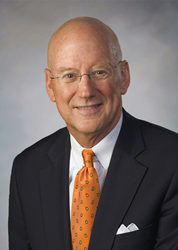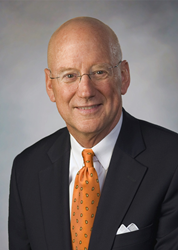
William L. Henrich, MD, MACP, president, UT Health San Antonio
“We have to respond with measures to lower the curve … and save lives.” — William L. Henrich, MD, MACP
SAN ANTONIO (PRWEB)
June 30, 2020
UT Health San Antonio’s president, William L. Henrich, MD, MACP, today called for San Antonio and communities nationwide to intensify their commitment to safe behaviors. San Antonio, the nation’s seventh-largest city, has seen a marked increase in COVID-19 cases since mid-June.
“As health care leaders, we are committed to our patients and communities during this pandemic,” Dr. Henrich said. “Our front-line health care providers are doing all they can to help San Antonio and surrounding communities stay healthy. Today, because of the recent surge in COVID-19 cases, I am announcing ‘We Can Stop the Spread,’ a public education initiative aimed at sustaining and increasing the simple behaviors that will keep us all safe.”
San Antonio and Bexar County reached 5,142 cases of COVID-19 on June 17, according to the COVID-19 dashboard of the San Antonio Metropolitan Health District. Hospitalized patients stood at 241, including 91 in an intensive care unit (ICU).
In only 12 days, by June 29, the San Antonio dashboard showed 10,787 cases. Hospitalized patients totaled 881, with 274 patients sick enough to be treated in ICUs. The surge is exponential in the nation’s seventh-largest city.
“We Can Stop the Spread is a most important undertaking,” Dr. Henrich said. “Our scientific experts are encouraging everyone to do their part by continuing to wash hands often, wearing a face covering in public, practicing social distancing and staying away from large social gatherings.”
Models of COVID-19’s impact on Bexar and surrounding counties suggest the number of hospitalized patients could continue to climb through August.
“We have a number of models that are guiding us in planning for hospitalizations and preparing for a surge of COVID-19 patients,” Dr. Henrich said. “Hospitals are obligated to keep a certain number of beds open to meet the demands of this possible public health emergency.”
The models are estimates based on variables such as the number of COVID-19 cases, deaths and the number of tests in an area.
“Back in March, April and May, we had a bump in our cases that was largely related to nursing homes and jails, and we didn’t have much community spread,” Dr. Henrich said. “But now what’s happening is we have a lot of community spread and the number of cases is increasing.
“The rapid increase is a cause for concern,” he said. “What I’m urging everyone to do now is to return to being careful about mask usage, personal hygiene with your hands, and staying out of crowded environments, especially crowded environments indoors.”
‘We’ve let our guard down’
More people are shopping, working, getting together for family or social gatherings, and carrying on with daily activities. And it seems fewer people are wearing masks out in public.
“We have what I refer to as ‘COVID virus fatigue’ with regard to our social interactions,” Dr. Henrich said. “We’ve let our guard down. We must counter this by wearing masks and returning to what thwarted the virus in the first place.”
San Antonio does not want to repeat what happened in Seattle, and later on a much bigger scale in New York, where the health care system was overwhelmed with the number of hospitalized people needing specialized care. Stress on the number of available ICU beds, the number of mechanical respirators and the available experts to treat the patients proved to be significant challenges.
“The whole idea is to not reach that threshold,” Dr. Henrich said.
The health care system needs flexibility to take care of other patients.
“Remember that heart disease, cancer, stroke, dementia and all the diseases that we usually focus on are still there,” Dr. Henrich said. “We want to be able to take care of those individuals and not have to squeeze the system with all of these infected COVID-19 patients.”
Young people are not immune
Patients of all ages are at risk of infection, and it is not only senior adults who are proving to be susceptible to COVID-19. A severe form of the disease has been seen in children. Meanwhile, young people in their teens, 20s and 30s are being treated in ICUs nationwide.
“COVID-19 is not a discriminator of age,” Dr. Henrich said. “It is being seen in all age groups.”
Upcoming summer activities make masking and social distancing even more necessary. Only safe behaviors can prevent a new peak of cases and hospitalizations from occurring in August.
To prevent this, members of the public must return to the basics:
-
Everyone should wear a mask or bandana. Do something that interrupts transmission of COVID-19 via aerosols from the mouth and nose. - Be meticulous in the way we wash our hands and how we touch surfaces. Try to avoid touching the face, eyes and nose. Use hand sanitizer.
- Avoid crowded indoor venues, especially a party atmosphere. Parties lead to relaxed close contact. “You don’t know if the person you’re talking to has inadvertently become infected, is a silent case and is shedding the virus,” Dr. Henrich said.
These basics work. We can stop the spread.
“We have to respond with measures to lower the curve, keep the medical system intact, take good care of the people who get sick, and save lives,” Dr. Henrich said.
“If we don’t, then we will be in a place where we have more collateral effects from the disease and heaven forbid, we will lose more people.”
# # #
Data sources: San Antonio Metropolitan Health District.
The University of Texas Health Science Center at San Antonio, also referred to as UT Health San Antonio, is one of the country’s leading health sciences universities and is designated as a Hispanic-Serving Institution by the U.S. Department of Education. With missions of teaching, research, patient care and community engagement, its schools of medicine, nursing, dentistry, health professions and graduate biomedical sciences have graduated more than 37,000 alumni who are leading change, advancing their fields, and renewing hope for patients and their families throughout South Texas and the world. To learn about the many ways “We make lives better®,” visit http://www.uthscsa.edu.
Stay connected with The University of Texas Health Science Center at San Antonio on Facebook, Twitter, LinkedIn, Instagram and YouTube.
To see how we are battling COVID-19, read inspiring stories on Impact.

